Tags
Andalucia, Andalusia, domestic cat, Donana National Park, Iberian lynx, lynx, myxomatosis, Naturetrek, Sierra Morena
Andalucia: Felines, at last! It has been suggested to me, from Canada, that if I wanted to see lynx I should have travelled to that country, where they are abundant. Ah – but our quest was for Iberian lynx! There are estimated to be only about 400 of these left in the wild, though recent conservation efforts have meant that this figure is fourfold what it was 15 years ago. It remains the world’s most endangered feline species. The two places we tried to see them, the Doñana National Park, and the Sierra Morena, are the best places to do so; there are more in the latter, but they are much more widely scattered there. Naturetrek did not guarantee a sighting – how could they? – but 80% of these trips had had positive outcomes.
The Iberian lynx, considerably smaller than the Eurasian version, is about the size of a boxer dog, and has wonderful ear tufts and a short stubby tail. Its main prey is rabbit, and there is great concern for its future because the rabbit population has considerably declined in recent years, the result of myxomatosis and other disease.
We saw no lynx during our first, morning, drive – but a pug mark, thought to be made the night before.

Notice the claw marks
And on the roads there were warning signs. 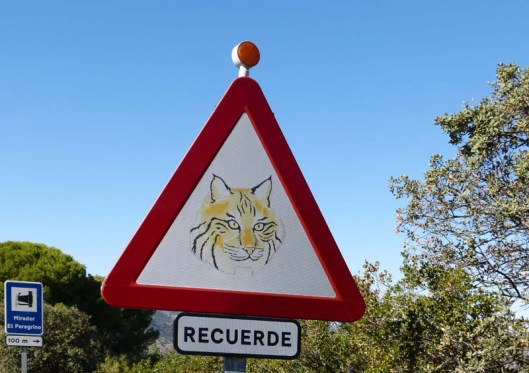 As we set off for our second, late afternoon, drive, we were told that a lynx had been spotted that morning eating large prey. We (Sergio and the driver) found the prey:
As we set off for our second, late afternoon, drive, we were told that a lynx had been spotted that morning eating large prey. We (Sergio and the driver) found the prey:

Probably a small deer
The lynx would not be likely to be far away from such a larder, and could well be sleeping its meal off. And eventually he – a magnificent nine-year-old male named Dardo (dart) – was spotted resting in the shade. 

He has a collar
 After a while, it was decided that we should move on to the one remaining patch of water in the vicinity, (see previous blog) and hope to see Dardo again on our return.
After a while, it was decided that we should move on to the one remaining patch of water in the vicinity, (see previous blog) and hope to see Dardo again on our return.

Lynx staple diet
He had scarcely moved, 90 minutes later. 




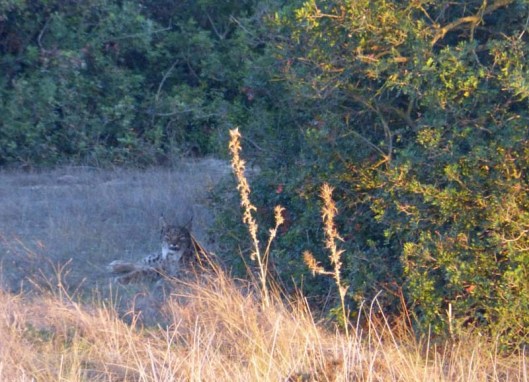
Not fazed at all by humans in a van staring at him, perhaps 50-80 metres away
 Night was closing in.
Night was closing in. 
 Huge sighs of relief from all leaders, and huge smiles of pleasure from wildlife tourists.
Huge sighs of relief from all leaders, and huge smiles of pleasure from wildlife tourists.
We returned quite early the next morning hoping to catch the lynx eating. He had finished though by the time we arrived, and was hanging around near where we had seen him the previous day. This is the best shot I could get, partly because it took me a while to spot him, despite others’ efforts to help, and partly because I was on the wrong side of the van to get into a good position.  But I was able actually to see him walking around for a few minutes, in and out of and behind the bushes. We decided to move on once he had finally disappeared, but just then a rangers’ van came up, someone leapt out, and went over to where the prey had been, and came back holding something.
But I was able actually to see him walking around for a few minutes, in and out of and behind the bushes. We decided to move on once he had finally disappeared, but just then a rangers’ van came up, someone leapt out, and went over to where the prey had been, and came back holding something.  We were most privileged to be shown the pictures his camera trap had taken the previous afternoon, before we had arrived there.
We were most privileged to be shown the pictures his camera trap had taken the previous afternoon, before we had arrived there. 
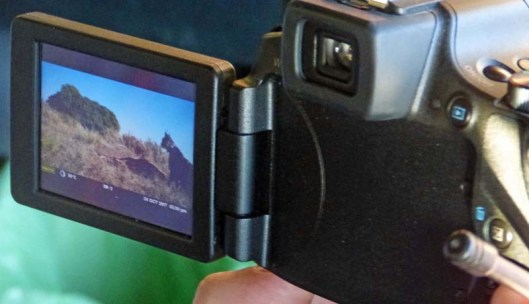

 Serendipity or what!
Serendipity or what!
No, we didn’t see any lynx in the Sierra Morena, just this old piece of lynx poo. 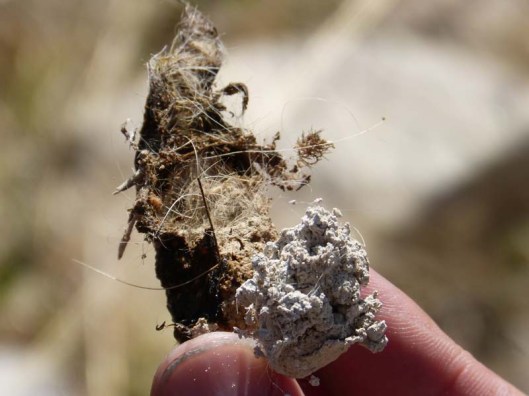 But there were compensations for cat lovers back at the hotel! Cats (domestic) and more cats and more cats! Mostly happy to accept caresses, with just one or two rather more nervous – perhaps having had bad experiences from previous guests, and some very friendly indeed. It was impossible to know how many there were, especially since they were nearly all black and white. There were two mothers, one of which was a sort-of Siamese, and it seemed to me that the rest were mainly 6-month-old kitlets with a couple of 3-month-olds.
But there were compensations for cat lovers back at the hotel! Cats (domestic) and more cats and more cats! Mostly happy to accept caresses, with just one or two rather more nervous – perhaps having had bad experiences from previous guests, and some very friendly indeed. It was impossible to know how many there were, especially since they were nearly all black and white. There were two mothers, one of which was a sort-of Siamese, and it seemed to me that the rest were mainly 6-month-old kitlets with a couple of 3-month-olds.
I do know there were at least 13 cats (and I suspect more), because when we came back to the hotel on our last day, I had a load of chicken ham on me, left over from lunch. As a result, when I got it out of my back pack, there were kittens into said back pack, after the smell, and then around my feet – 12 of them. One mother cat was absent from this feast, so that meant there were at least 13 cats in total at the hotel. I didn’t manage to get a photo of the blissful experience of having 12 cats round my ankles, as I didn’t want to get my camera greasy, but here is a selection of the photos I got at other times. (Felinophobes, jump to the last picture.)

This is the one I would have kept in my back pack and brought back to the UK!


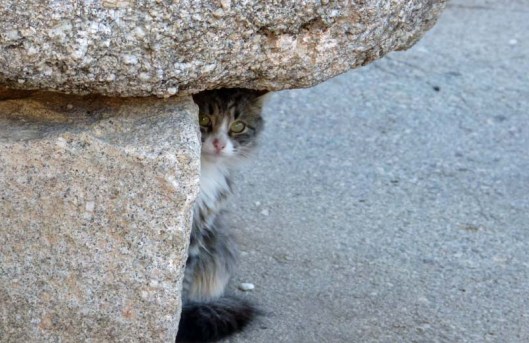
Or perhaps this one, though it was a little shy

I counted 6 in this hidey hole at one point, but it is not easy to get a good picture of six blackish cats in the shade!

One of the two mothers


I believe this granite piece was once used to crush olives


 Apart from treats from guests, the staff made sure the cats were well fed and watered. This final picture shows a completely different and very admirable creature profiting from their bounty, at the start of a long journey, presumably back to a nest.
Apart from treats from guests, the staff made sure the cats were well fed and watered. This final picture shows a completely different and very admirable creature profiting from their bounty, at the start of a long journey, presumably back to a nest.  I really, really enjoyed my eight days in Andalucia, and it has really given me a great desire to go back – to see more of its rich cultural heritage, and also, perhaps at a different time to year, once more to explore Doñana National Park.
I really, really enjoyed my eight days in Andalucia, and it has really given me a great desire to go back – to see more of its rich cultural heritage, and also, perhaps at a different time to year, once more to explore Doñana National Park.

How wonderful to see that Lynx and get such good photographs.
LikeLike
Thank you Susan – it was a great holiday.
LikeLike
Wow – what a cat-fest! That lynx is magnifique! And the mammy cat with some Siamese in her is rather gorgeous too. A great trip all round! XX
LikeLike
The other mammy cat was – you’ve guessed it – black and white. I think here must have been a long-haired daddy cat not far!
LikeLike
Great pictures of the lynx.
LikeLike
I understand that we were very fortunate being so close. Any sightings in the Sierra Morena would have been pretty distant.
LikeLike
Great pictures – am so glad you were able to see a lynx. It must have been a wonderful trip, and a treat for a cat lover like you to have so many at the hotel.
LikeLiked by 1 person
Quels beaux coups de chance (voir le lynx de près, voir la vidéo du ranger). Comme à ton habitude ! Tu devrais te faire engager comme mascotte d’expédition 😉 Ta photo du 2e matin est parfaite pour comprendre le mimétisme de la robe du lynx. Celle du chaton sous son “dolmen” est mignonne comme tout. Je comprends que tu aies eu envie de ramener un passager clandestin… Dommage que ce soit déjà fini, j’aurais bien continué à voyager avec toi.
LikeLike
My next wildlife trip is in February – very different…
LikeLike
Patience is definitely a virtue !
LikeLiked by 1 person
Very nice trip and story, I need to check how to visit Donana, last time I did I understood that is not really for mass tourism…Very nice place, and indeed Lynx is a wonderful animal which requires our attention and protection! Thanks, stay in touch!
LikeLike
Thank you. As I understand it you have to go to the ‘exclusive’ area with a group, but that’s certainly worth checking out. Thanks also for following me. My next wildlife trip is to Yellowstone NP in February – if it’s not closed because the Federal Budget hasn’t been agreed, I have visit to relative planned for New Hampshire and California either side of the tour, so I shall certainly be crossing the Pond to fulfil those.
LikeLiked by 1 person
Thanks for the tip, I surely will try again going to Donana! By Feb there will be a new year federal budget, so surely Yellowstone will be open, and it is awesome that time of the year, you can see well in the distance with a good camera! Take a lot of wildlife pictures, and enjoy!! The first National Park of the world is surely a wonder worth seeing!!
LikeLiked by 1 person